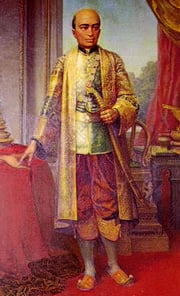Rama II
Phuttaloetla Nabhalai, Rama II, now known as Buddha Loetla Nabhalai (February 24 1767–July 21 1824), was the son of King Rama I and Queen Amarindra, he was born at his mothers home at Amphoe Amphawa in present day Samut Songkhram Province. He was the second king of the Chakri dynasty. His father, Rama I had extended Thai territory and driven off the Burmese, who had occupied part of the kingdom. His reign as King of Siam (1809–1824) brought in a renaissance of Thai arts and culture, especially in literature. Rama II had seventy-three children.
Biography
During Rama II's reign, Thailand experienced a confrontation with Vietnam, then becoming a major power in the region, over control of Cambodia in 1813 which his father had brought under Thai rule. Western influences had begun to be felt in Southeast Asia and in Thailand. In 1785 the British occupied Penang, and in 1819 they founded Singapore. Soon the British displaced the Dutch and Portuguese as the main Western economic and political influence in Thailand. The British objected to the Thai economic system, in which trading monopolies were held by royal princes and businesses were subject to arbitrary taxation.
Relations with the British Empire
In 1821 the government of British India sent a mission to demand that Thailand lift its restrictions on free trade. They saw Thailand as a route to China. Thailand also had Teak timber, and some mineral resources. Two attempts were made in in 1821 to secure a commercial treaty between Singapore and Thailaind, both of which were unsuccessful. The first attempt was led by John Morgan, the second by John Crawfurd, later British Resident of Singapore (1824 - 1826). [1]. After recently throwing off Burmese occupation and establishing their autonomy as an independent power in the region, the Thai people were caution about encouraging foreign presence in their territory. However, trade treaties with Britain were to be negotiated under Rama II's son, Rama III. As British power increased to the West of Thailand and French to the East, the Thai kings, in what proved to be a successful bid to protect their independence, negotiated treaties with both imperial powers that made some territorial and trade concessions in return for the promise that neither would invade. Instead, the British and the French agreed to regard Thailand as a neutral buffer-zone between their two empires.
| Chakri Dynasty Born: 24 February 1767; Died: 21 July 1824 | ||
|---|---|---|
| Preceded by: Buddha Yodfa Chulaloke |
King of Siam 1809–1824 |
Succeeded by: Jessadabodindra |
Template:Noble-stub
war:Buddha Loetla Nabhalai
Credits
New World Encyclopedia writers and editors rewrote and completed the Wikipedia article in accordance with New World Encyclopedia standards. This article abides by terms of the Creative Commons CC-by-sa 3.0 License (CC-by-sa), which may be used and disseminated with proper attribution. Credit is due under the terms of this license that can reference both the New World Encyclopedia contributors and the selfless volunteer contributors of the Wikimedia Foundation. To cite this article click here for a list of acceptable citing formats.The history of earlier contributions by wikipedians is accessible to researchers here:
The history of this article since it was imported to New World Encyclopedia:
Note: Some restrictions may apply to use of individual images which are separately licensed.
- ↑ >"Ode to Friendship: Celebrating Thailand-Singapore Relations" Ode to Friendship: Celebrating Thailand-Singapore Relations Retrieved October 8, 2007
